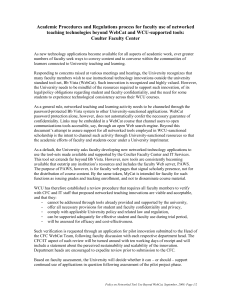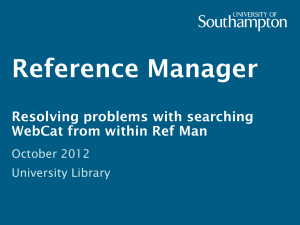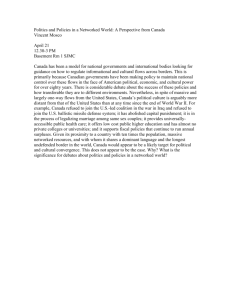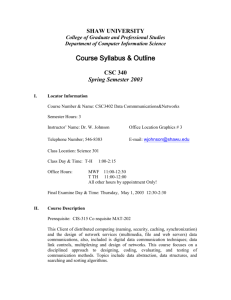APR 16: Process for Faculty Use of Networked Teaching Technologies beyond
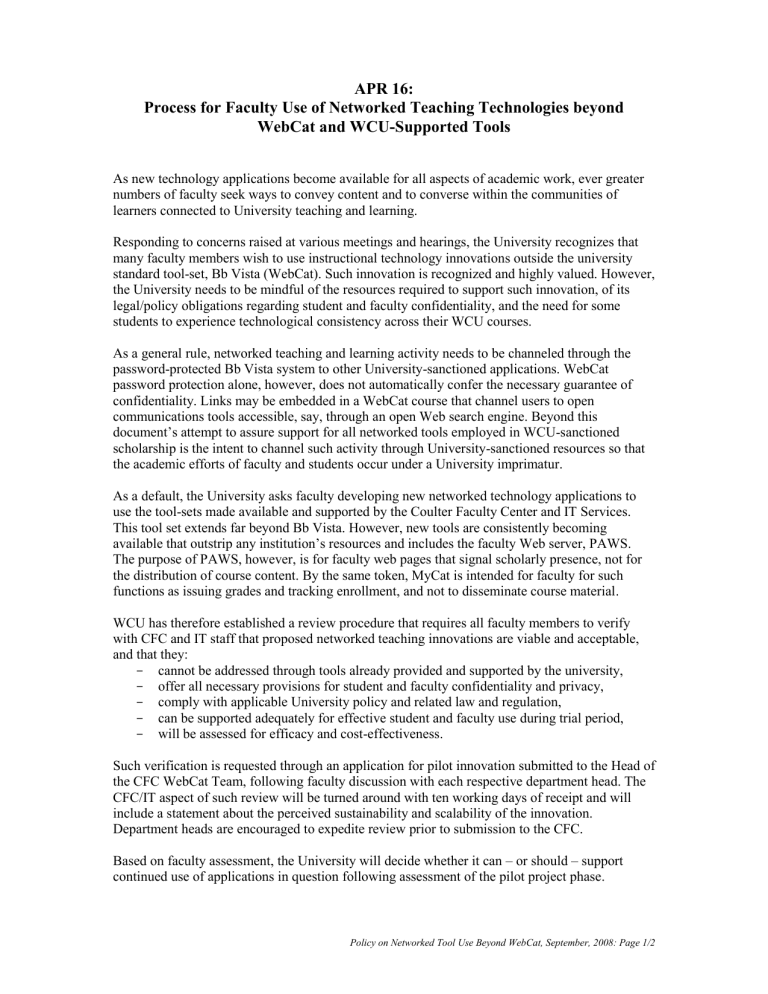
APR 16:
Process for Faculty Use of Networked Teaching Technologies beyond
WebCat and WCU-Supported Tools
As new technology applications become available for all aspects of academic work, ever greater numbers of faculty seek ways to convey content and to converse within the communities of learners connected to University teaching and learning.
Responding to concerns raised at various meetings and hearings, the University recognizes that many faculty members wish to use instructional technology innovations outside the university standard tool-set, Bb Vista (WebCat). Such innovation is recognized and highly valued. However, the University needs to be mindful of the resources required to support such innovation, of its legal/policy obligations regarding student and faculty confidentiality, and the need for some students to experience technological consistency across their WCU courses.
As a general rule, networked teaching and learning activity needs to be channeled through the password-protected Bb Vista system to other University-sanctioned applications. WebCat password protection alone, however, does not automatically confer the necessary guarantee of confidentiality. Links may be embedded in a WebCat course that channel users to open communications tools accessible, say, through an open Web search engine. Beyond this document’s attempt to assure support for all networked tools employed in WCU-sanctioned scholarship is the intent to channel such activity through University-sanctioned resources so that the academic efforts of faculty and students occur under a University imprimatur.
As a default, the University asks faculty developing new networked technology applications to use the tool-sets made available and supported by the Coulter Faculty Center and IT Services.
This tool set extends far beyond Bb Vista. However, new tools are consistently becoming available that outstrip any institution’s resources and includes the faculty Web server, PAWS.
The purpose of PAWS, however, is for faculty web pages that signal scholarly presence, not for the distribution of course content. By the same token, MyCat is intended for faculty for such functions as issuing grades and tracking enrollment, and not to disseminate course material.
WCU has therefore established a review procedure that requires all faculty members to verify with CFC and IT staff that proposed networked teaching innovations are viable and acceptable, and that they:
cannot be addressed through tools already provided and supported by the university,
offer all necessary provisions for student and faculty confidentiality and privacy,
comply with applicable University policy and related law and regulation,
can be supported adequately for effective student and faculty use during trial period,
will be assessed for efficacy and cost-effectiveness.
Such verification is requested through an application for pilot innovation submitted to the Head of the CFC WebCat Team, following faculty discussion with each respective department head. The
CFC/IT aspect of such review will be turned around with ten working days of receipt and will include a statement about the perceived sustainability and scalability of the innovation.
Department heads are encouraged to expedite review prior to submission to the CFC.
Based on faculty assessment, the University will decide whether it can – or should – support continued use of applications in question following assessment of the pilot project phase.
Policy on Networked Tool Use Beyond WebCat, September, 2008: Page 1/2
Application Form for Faculty Use of Networked Teaching Technologies beyond
WebCat and WCU-Supported Tools
1.
Faculty member name:
2.
Name and number of course:
3.
Semester in which proposed innovation is to be incorporated (proposed start and end dates for the experimental innovation):
4.
Brief statement of instructional activity that proposed innovation is designed to support:
5.
Brief statement addressing why tools already supported by WCU are inadequate to support the instructional activity envisioned:
6.
Brief statement assuring that FERPA requirements and other legitimate concerns of confidentiality and privacy will be assured:
7.
Brief statement describing how the support/training needs of students and faculty will be assured in the absence of CFC/IT Services support:
8.
Brief statement regarding the assurance of adequate student access to the tools proposed:
9.
Brief statement describing how the instructional and technical efficacy of this innovation will be assessed (assessment must include student perception):
10.
Brief statement on the costs, benefits and sustainability of the innovation, including up-front and ongoing costs to support the innovation:
Faculty signature and date:___________________________________________________
Dept. Head signature and date:________________________________________________
Policy on Networked Tool Use Beyond WebCat, September, 2008: Page 2/2
